 |
 |
 |
| |
LONG-TERM PRE-HAART SURVIVORS OF HIV:
A SPECIFIC GROUP WITH SPECIFIC NEEDS - 'high rates of mental & physical impairments'
|
| |
| |
.....'high rates of depression (30%), 50% cognitive dysfunction, slow gait speed, having falls in last year 15%, 3-4% unable to walk independently, 20% poor lower extremity function, in pain (30% to 40%), living alone 30%, low rates of social supports/contacts (30%), quality of life poor 2-6%, moderate 29%, very good 10%, very good 50%. Pre frailty around 50%. Polypharmacy 20% (>5 meds). 2 people in nursing home.
10th International Workshop on HIV and Aging, October 10-11, 2019, New York
Reported by Jules Levin
F. Brañas1, M. Ramírez2, MJ. Galindo3, M. Torralba4, P. Ryan1, F. Dronda5, I. Machuca6, C. Busca7, A. Antela8, J. Vergas9, MJ. Bustinduy10, A. Cabello11, M. Sánchez-Conde5.
1Hospital Universitario Infanta Leonor. Universidad Complutense. Madrid. 2Hospital Universitario Gregorio Marañon. Madrid. 3Hospital Clínico Universitario de Valencia. Valencia. 4Hospital Universitario de Guadalajara. Guadalajara. 5 Hospital Universitario Ramon y Cajal. Irycis. Madrid. 6Hospital Universitario Reina Sofía. Cordoba. 7Hospital Universitario La Paz. Madrid. 8Complejo Hospitalario Universitario de Santiago. Santiago. 9Hospital Clínico San Carlos. Madrid. 10Hospital Universitario Donostia. San Sebastián. 11Fundacion Jiménez Díaz. Madrid. SPAIN.
from Jules: this study from Spanish aging researchers looked at >50 year olds HIV+, and compared LTSs (defined as diagnosed in 1996 or earlier) to 50 year olds diagnosed between 1997-200 & after 2000. Rates of comorbidities were HIGH for all including cognitive dysfunction (poor MOCA test performance for around 50%), slow gait in large % of people over 50, depression (around 30% depression using GDS-SF test; table 3a), having falls, about 4% performed poor on test of independence (Barthel Index), around 20% performed poorly on SPPB test of lower extremity function & mobility; quality of life was rated poor by 5.9% of LTS and 1.6% to 2.8% of others >50 (see Table 3b), very good QOL was 10% by LTS, 36% had moderate-poor QOL among LTSs. 30% reported living alone. Low percents reported "social contacts" & "social supports", (around 30%). Frailty (figure 3) was 3.7% in LTSs but pre-trait was 56.9% & 39% were robust).
------------------------------------------------
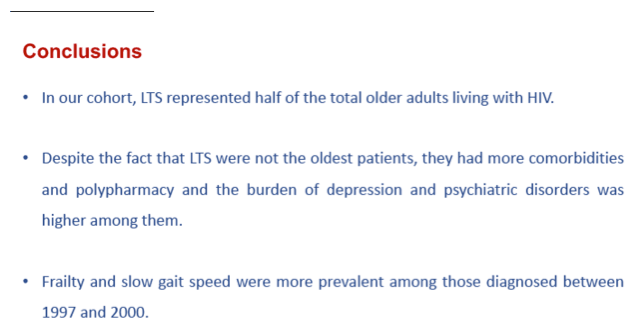
program abstract
Long-term pre-HAART survivors of HIV: a specific group with specific needs
Brañas F1, Ramírez M2, Galindo M3, Torralba M4, Ryan P1, Dronda F5, Machuca I6, Busca C7, Antela A8, Vergas J9, Bustinduy M10, Cabello A11, Sánchez-Conde M5
1Hospital Universitario Infanta Leonor, Madrid, Spain, 2Hospital Universitario Gregorio Marañon, Madrid, Spain, 3Hospital Clínico Universitario de Valencia. , Valencia, Spain, 4Hospital Universitario de Guadalajara, Guadalajara,
Madrid, 5Hospital Universitario Ramon y Cajal. Irycis, Madrid, Spain, 6Hospital Universitario Reina Sofía , Cordoba, Spain, 7Hospital Universitario La Paz., Madrid, Spain, 8Complejo Hospitalario Universitario de Santiago, Santiago, Spain, 9Hospital Clínico San Carlos, Madrid, Spain, 10Hospital Universitario Donostia, San Sebastián, Spain, 11Fundacion Jiménez Díaz, Madrid, Spain
Background: Nearly half of people living with HIV (PLWH) in Europe are 50 years old or older. Some of them were diagnosed before the modern era of effective HIV drugs known as "long-term pre-HAART survivors" (LTS), while others are newly diagnosed. Our objective was to evaluate differences between older PLWH LTS and non-LTS.
-
Methods: Prospective cohort study. Patients from the "HIV-FUNCFRAIL: Multicenter spanish cohort to study frailty and physical function in 50 years or older HIV-infected patients" were included and stratified by year of diagnosis: < 1996, 1997-2000, >2000. We recorded sociodemographic data, comorbidities, variables related to HIV infection, frailty, physical function, and the risk of 5-year all-cause mortality measured by VACS index.
Results: We evaluated 540 PLWH who were 50 years old or over, of which 272 (50.3%) were LTS. (15% were >65)
Differences were found regarding the proportion of older than 65 years [6.6% in the LTS, 18% in the 1997-2000 group and 22.3% in the >2000 group (p=0.0001)], the proportion of women [30% in the LTS, 23.6% in the 1997-2000 group and 19.7% in the >2000 group (p=0.04)] and in the risk practice for HIV infection (p=0.0001).
No significant differences were found regarding median current CD4+ T-cell count, median CD4/CD8 ratio and the proportion of patients with undetectable viral load.
LTS suffered significantly more from: OCPD (p= 0.001), depression (p=0.018), psychiatric disorders (p=0.0001) and osteoarticular pathology (p=0.03). No differences were found regarding: cardiovascular risk factors, ischaemic heart disease, cerebrovascular disease and chronic kidney failure.
Polypharmacy was prevalent among LTS [ 25.5% in the LTS, 25% in the 1997-2000 group and 15.6% in the >2000 group (p=0.03)], and particularly the use of neuroleptics (p=0.003), benzodiazepines (0.007) and hypnotics (p= 0.009).
Differences were found regarding mean BMI [24.7 (SD 4.2) in the LTS, 26 (SD 4.2) in the 1997-2000 group and 26.7 (SD 4.3) in the >2000 group (p=0.01)], frailty [3.7% in the LTS, 10.1% in the 1997-2000 group and 6.4% in the >2000 group (p=0.01)], and in gait speed < 0.8m/s [3.7% in the LTS, 9% in the 1997-2000 group and 5.1% in the >2000 group (p=0.01)]. No differences were found regarding cognitive impairment (MOCA-test) and the risk of 5-year all-cause mortality measured by VACS index.
Conclusions: In our cohort, LTS represented half of the total older adults living with HIV. Despite the fact that LTS were not the oldest patients, they had more comorbidities and polypharmacy and the burden of depression and psychiatric disorders was higher among them. Frailty and slow gait speed were more prevalent among those diagnosed between 1997 and 2000.
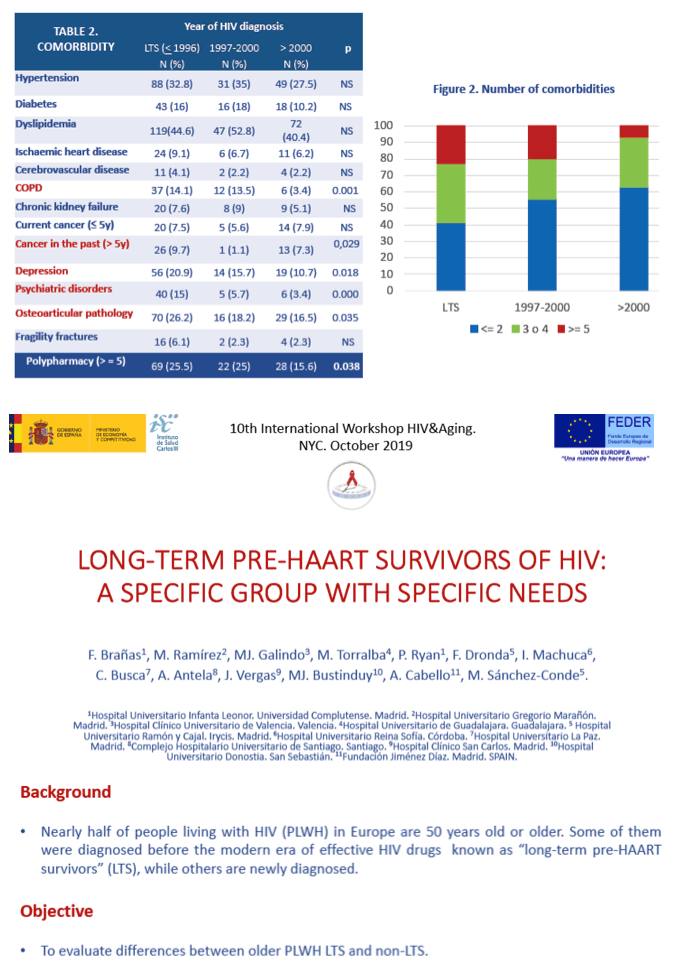
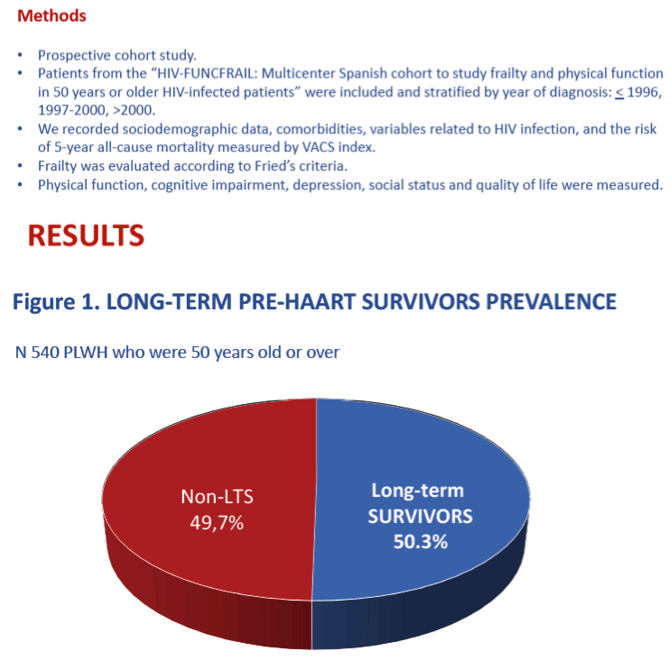

More than 20 years ago the 30-item GDS was developed as a self-report instrument to screen for clinical depression among the elderly (4). The Geriatric Depression Scale (GDS) is a 30-item self-report assessment used to identify ... A short version of the GDS (GDS-SF) containing 15 questions has been developed, and the scale is available in languages other than English. A score of 5 or more suggests depression
The Montreal Cognitive Assessment (MoCA) was designed as a rapid screening instrument for mild cognitive dysfunction. It assesses different cognitive domains: attention and concentration, executive functions, memory, language, visuoconstructional skills, conceptual thinking, calculations, and orientation.
Scores on the MoCA range from zero to 30, with a score of 26 and higher generally considered normal. In the initial study data establishing the MoCA, normal controls had an average score of 27.4, compared with 22.1 in people with mild cognitive impairment (MCI) and 16.2 in people with Alzheimer's disease.
The Barthel Scale/Index (BI) is an ordinal scale used to measure performance in activities of daily living (ADL). Ten variables describing ADL and mobility are scored, a higher number being a reflection of greater ability to function independently following hospital discharge.Time taken and physical assistance required to perform each item are used in determining the assigned value of each item. The Barthel Index measures the degree of assistance required by an individual on 10 items of mobility and self care ADL. [1]
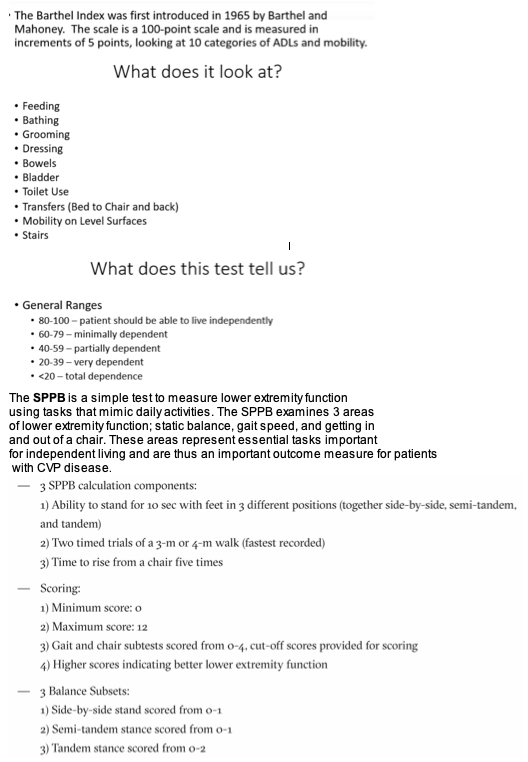
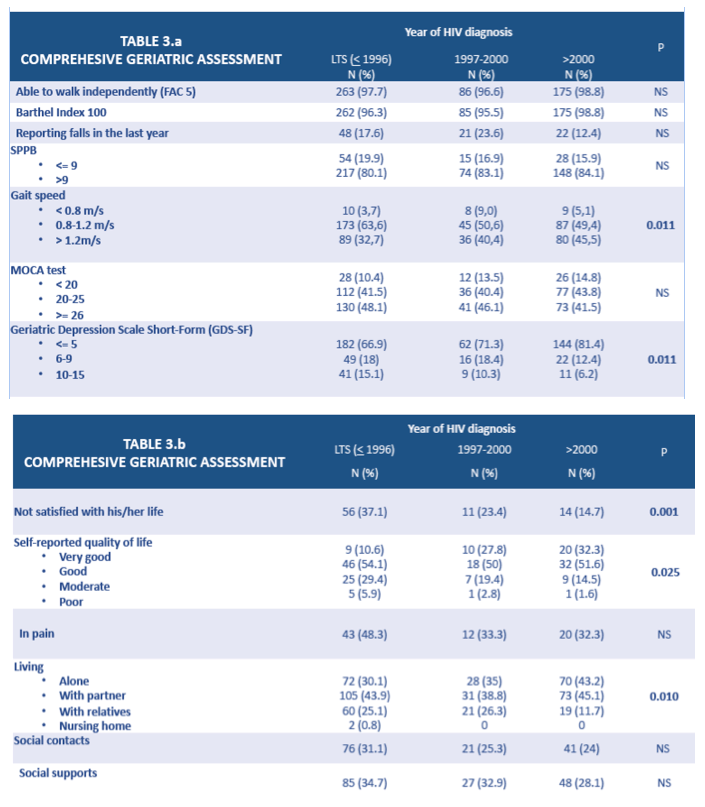
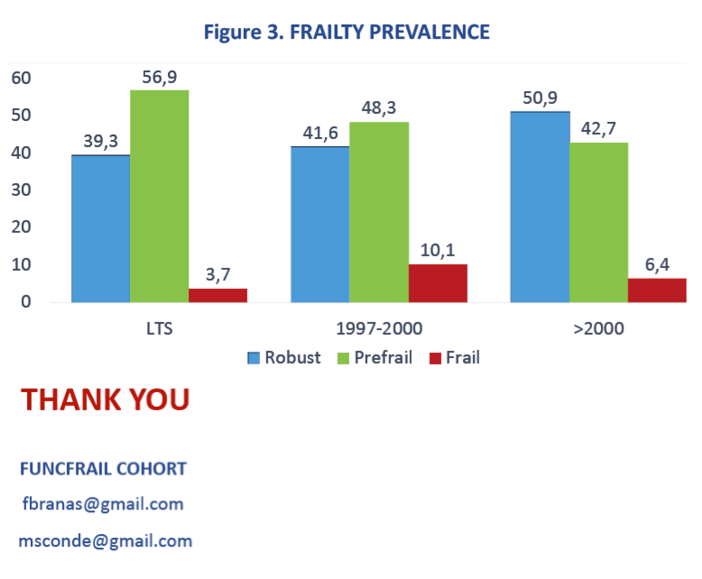
|
| |
|
 |
 |
|
|